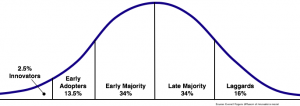Increasing the Odds of Success: Don’t Expect Cascading Miracles
October 21, 2011 Leave a Comment
Recently one of our investors asked me to meet with a friend of his who had his own startup and was looking to raise money. I often get asked to look at startup companiesor ideas by people in my network to let them know what I think. Typically it is because they are looking to make an investment, join the company or want me to give them advice on starting their own company. I both love and hate doing this. What I do like is learning about new companies and the problems they solve, the different spin each one of them has and most importantly seeing how other entrepreneurs work. What I don’t like is when I have share with another entrepreneur what I really think about their idea. You see, like any VC will tell you, most ideas that I see aren’t venture fundable. However, unlike most VCs, I feel I have an obligation as an entrepreneur who has been around the block a couple of times to be candid in my feedback about the prospects for their company based on what I learned (so far). In my mind, since I personally don’t have an agenda, I feel giving the entrepreneur feedback that other folks may not share with them can be pretty helpful. I know I want to hear that kind of stuff, even if it hurts. Anyone who knows me well knows that if asked I am pretty candid about my assessments. And while I am occasionally wrong, I have saved my network lots of money and time (last year I helped one of my investors save over $1M).
So when I was asked to meet a fellow entrepreneur I agreed to meet for breakfast with my investor’s friend who was working on a new kind of calendaring product.
Evaluating a Startup for Investment
Before our meeting, I checked out his website and saw that I needed to complete the site’s registration process in order to see the product. Immediately a flag went up in my head when I couldn’t use my Facebook, Google or Twitter profile to authorize the app. In 2011 there is basically no excuse not to offer at least one of these login options for a consumer application. I also checked out the founder’s profile on LinkedIn and saw he had some phenomenal PD experience at one of the most successful consumer technology companies around so he knew how to build great products. Heading to breakfast I didn’t know what to expect but I was hoping my initial login issue was just a beta release nit and that I would be blown away by when I learned more about what he was doing.
At breakfast I was pretty impressed with my fellow entrepreneur’s background. Great product and technology experience. Also lots of startup stints, so he knew what he what he was getting into.
We started by him explaining the problem he was trying to solve. And it is clearly a big problem that many people have. And many people have tried unsuccessfully to solve. There are dozens of free competitive/substitute solutions in market. None have solved the problem completely, but most people use some solution that solves part of the problem. So, kudos to him for trying to solve a big unmet need.
He spent a few minutes giving me a demo of his product and it was clear he knew how to build software. The UI was very attractive, looked pretty easy to use and had lots of features that would be needed to complete the most common jobs to be solved. But as I started asking questions about what it would take to make the product work well for most users things started to unravel pretty quickly. It turns out that a lot of the content required to populate the application would need to come in via a feed similar to an RSS feed. These feeds would be provided by both large and small publishers. It turns out that most sites do not offer this kind of feed. It would also require users of the application to know how to import these feeds. I don’t know about you, but I never figured out how to use RSS feeds properly. If it weren’t for the Rockmelt browser that basically did it for me, I would never use feeds. I couldn’t imagine your average user to be able to know how to import feeds for this app. In fact the overall product seemed like it would be easy to use IF it was an enterprise application, but it was a consumer application. It was apparent that it was not drop dead simple to figure out how to make it work for most users given the nuance of how each event could be created and shared.
Risk factors:
I then started going down the typical list for evaluating companies…user acquisition, retention, monetization, network effects etc. It turns out my sign on process wasn’t misguided. There was not social networking capabilities built into the product other than email notifications. Non-event organizers would not need to use the software and probably wouldn’t want to given the limited benefit unless everyone they knew used it too. Hmmmm. Retention was dependant on power users but lots of light users – kind of like Evite but without the pageviews.
So there was nothing built into the product that was social or incentivized non-users to use the product themselves. The target would then be power users with no easily identifiably attribute to be able to find them in a haystack.
Given the competitive landscape he couldn’t charge for the product and I have my doubts about the other monetization options given all the factors that need to work in order to make the big bucks. The current plan for monetization was contextual advertising and selling content (specialized feed and template) subscriptions. Advertising seemed to be too distant from the core problem being solved to be able to capture high conversion rate CPAs and the subscriptions could work, but for a small market.
The best definition I have heard for marketing is “Identify a consumer need, meet a consumer need”. But for an entrepreneur I have added a word… “Identify a consumer need, meet a consumer need, profitably”. While it takes skill to build a great product, there are lots companies that can create products that solve a big unmet need, but never make any money.
Cascading Miracles
You see the challenge I found with this company and many other companies I have looked at is that they needed cascading miracles in order to be successful. A hard product problem in general just to make the product easy, heavy users needed to know how to use feeds, publishers needed to provide them, users somehow needed to find the product, somehow making money would have to come together. This is way too many risk factors for a startup. The probability of success just seemed too low.
I shared with my fellow entrepreneur my appreciation for him tackling a real, hard problem. But I also questioned the number of challenges he was going to face in order for his company to succeed. We both understood the incredible effort required to scale a startup even in the best of conditions, why would you make your life so stressful by tackling something that would be hard almost every step of the way? It takes just as much energy to build a company that only requires one miracle to succeed as one that requires three or four. So why would you choose an idea/ product/ comapny that needs more than one (or maybe two if you feel really confident or have lots of cash)? Life is too short to depend on cascading miracles for your company’s success especially if it isn’t riding any waves that give you huge momentum these days like social, mobile or local.
Facing Reality
At the end of our conversation I shared with him that I thought his startup fell in the bottom half of all startups that I see. It was probably the bottom of the third quartile. No one likes to hear their baby is ugly. I know I never liked hearing the truth about what was wrong with my startups. In reality he could pivot and make something of his technology. This introduces a topic for another blog entry about how entrepreneurs can often get too attached to their ideas and develops blind spots to the realities of their company. I wished him luck and advised my investor to pass on the opportunity.


